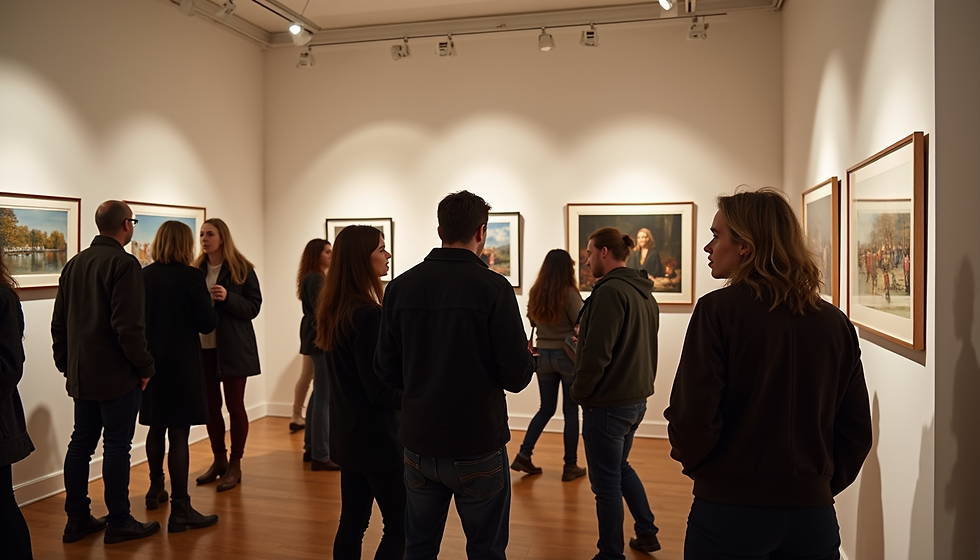The Role of Galleries in Showcasing Unique Art
- Amanda Petersen
- Jul 21
- 4 min read
Art galleries play an essential role in the art world. They are not just spaces to display art; they are cultural hubs that connect artists and audiences, offer a platform for emerging talent, and inspire community engagement. Galleries nurture creativity and help to disseminate unique artistic expressions, making them critical in the promotion of the arts.
Understanding Art Galleries
Art galleries come in various forms, from small indie spaces to large established institutions. Each serves a unique function in the art ecosystem. Independent galleries often focus on showcasing local or emerging artists, fostering creativity within their communities. Larger institutional galleries typically house renowned collections and major exhibitions that can attract national and international attention.
Galleries curate exhibitions to tell stories, spark conversations, and challenge perceptions. They carefully select artwork that aligns with their vision, fostering a cohesive experience for viewers. This not only enhances the aesthetic appeal but also provides context that enriches the viewer’s understanding of art.

The Impact of Art Galleries
The impact of art galleries extends beyond the walls of their spaces. They serve as a bridge between artists and their audience, allowing for direct engagement. By hosting exhibitions, openings, and talks, galleries provide opportunities for artists to discuss their work, share their inspirations, and connect with viewers. This dialogue can lead to increased sales, collaborations, and critical acclaim for the artists.
Furthermore, galleries can significantly boost local economies. According to a study by the National Endowment for the Arts, the arts contribute around $877 billion to the U.S. economy each year. This revenue comes from various sources, including art sales, tourism, and community engagement activities. Galleries attract visitors who not only appreciate art but also contribute to surrounding businesses like cafes, shops, and hotels.

Supporting Emerging Artists
One of the most significant roles of galleries is to support emerging artists. Many artists struggle to find platforms to showcase their work. Galleries provide this opportunity, giving artists the exposure they need to reach wider audiences. A successful exhibition can launch an artist's career, leading to interviews, press articles, and even representation from larger galleries.
Moreover, galleries often offer mentoring programs, workshops, and materials for developing artist skills. For instance, many galleries have artist-in-residence programs that encourage collaboration and experimentation. This not only helps the artist but also enriches the gallery's offerings.
Artists displayed in galleries often include a variety of styles, mediums, and cultural backgrounds. Diversity in art allows for richer storytelling and a more profound connection with viewers, reflecting a broader human experience. The more diverse a gallery’s collection, the greater its potential to engage different communities.
Promoting Art Education
Art galleries are not just exhibition spaces; they are also vital educational resources. Many galleries provide workshops, lectures, and educational programs aimed at teaching art appreciation to the public. These programs empower individuals by increasing their understanding of artistic techniques, history, and terminology.
Schools and universities often collaborate with art galleries for field trips or special projects. Such partnerships help students connect with the art world, encouraging creativity and critical thinking. By actively engaging young minds in art, galleries play a crucial role in nurturing the next generation of artists and art lovers.
A successful example is the partnership between the Chicago Art Institute and local schools. They have created programs that allow students to spend time in galleries, interact with curated exhibits, and even create their own art inspired by what they learn.

Community Engagement Through Art Galleries
Art galleries also serve as community anchors. They bring people together, fostering a sense of belonging and cultural identity. Many galleries host local artists, perform outreach, and curate community-driven projects that reflect the needs and stories of the neighborhoods they serve.
Community engagement can take various forms. From art walks to neighborhood forums, galleries create opportunities for collaboration. When local artists showcase their work in a gallery, it invites community members to participate and express their unique perspectives. This, in turn, nurtures cultural pride and strengthens community ties.
For example, New York's Brooklyn Museum has initiated various community engagement projects, allowing local residents to have their voices heard and represented in exhibitions. This fosters a stronger connection between artists and the community, enhancing the overall impact of the art.
The Future of Art Galleries
As we move forward, the role of art galleries continues to evolve with technology and societal changes. Online galleries and virtual exhibitions have emerged as an essential component in making art more accessible. They allow galleries to showcase their collections to worldwide audiences, breaking the limitations of physical space.
Furthermore, social media platforms give galleries a powerful tool for outreach and marketing. Visual platforms like Instagram are particularly advantageous for visual artists to share their work, while galleries can engage potential buyers and collectors in real time.
Despite these advancements, nothing can replace the physical experience of viewing art in person. The tactile interaction, the energy of the artworks, and the ambiance of an exhibit create something unique that virtual experiences cannot replicate. Thus, galleries must find ways to combine both digital and physical experiences to remain relevant in the future.





Comments